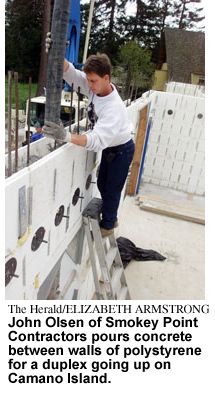 |
|
|
YOUR
COUNTY.
|
YOUR
BUSINESS JOURNAL.
|
Published July 2001
Concrete, foam construction saves energy, time
By
Kathy Day
Herald Economy Writer
CAMANO ISLAND — Mary Campbell’s construction project on W. Camano Drive draws lots of stares.
But the 30-year island resident, who said she’s “not a very conventional person,” spent a lot of time studying insulated concrete forms as a building method before she embarked on the duplex that sits next to her log home.
 Now,
she has John Olsen of Smokey Point Contractors hard at work finishing
the structure, which consists of two 1,500-square-foot homes with single-car
garages for each in the middle. When the project is done, she said, “it
will be able to take 250-mile gusts.”
Now,
she has John Olsen of Smokey Point Contractors hard at work finishing
the structure, which consists of two 1,500-square-foot homes with single-car
garages for each in the middle. When the project is done, she said, “it
will be able to take 250-mile gusts.”
Instead of using wood to frame the houses, Olsen is using interlocking polystyrene forms called ARXX High Performance Wallsystems. The forms amount to building blocks like Legos, he said.
They’ve been used to build schools, offices, hotels and banks as well as homes around the world, company officials said.
Campbell said she wanted to use the insulated concrete forms because “it’s a noisy corner and they’re practically soundproof.”
“I also knew electricity was going to be a problem and wanted a more efficient house,” she added. “Besides that, the footings are concrete, too, and there’s no wood below ground, so the chances for termites are reduced.”
Once the foundation is poured and the footings are installed, the fun begins, Olsen said.
Walls go up section by section, with windows, door openings and electrical boxes cut with a small folding saw. Fasteners that bind the walls together are inserted along with rebar for structural strength, and then concrete is poured. The foam exterior remains in place, and exterior and interior walls are attached directly to it.
When the project is done, leftover or damaged pieces can be recycled, he said.
It takes about an hour to set up two rows of the blocks and attach the anchor bolts that hold the frame, Olsen said, noting that gaps between them and around openings are sealed with foam.
While ARXX literature notes that the “walls stand up to forces of time and nature,” Campbell conceded she had problems with her first attempt using a different product. The large windstorm that blew through the area in mid-December knocked down part of the walls before they could be filled with concrete. It was then that she turned to Olsen to repair the damage and finish the project.
Olsen said 11 different firms make some type of insulated concrete forms — ICFs as they’re known in the trade. He said he likes ARXX best because they go together faster and are easier to work with than others he has seen.
“They cost about 7 percent more than a conventional building,” he said, “but it saves in terms of carpenters and energy costs down the road.”
Time savings, about three to four weeks, cut down on construction financing costs and save the homeowner on the front end, he added. “It’s also a lot easier on crews.”
With the concrete acting as an insulated thermal mass and the exterior and interior foam serving as even more insulation, the walls are draft-free, the company’s literature states. And some who have built with its product have seen energy bills reduced by as much as 70 percent.
The company’s claims are backed by industry studies, including one done in 1997 by the National Association of Homebuilders Research Center.
Tim Carter, a nationally syndicated columnist, wrote that “the ICF method of construction is so revolutionary that I venture to say it will go down in history right next to asphalt shingles, drywall, plywood and plastic laminate.”
Although Island County officials weren’t familiar with the ARXX system, Olsen said, with a few minor changes to engineering drawings from the original plans, they met all codes and engineering standards.
© The Daily Herald Co., Everett, WA








